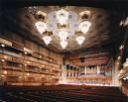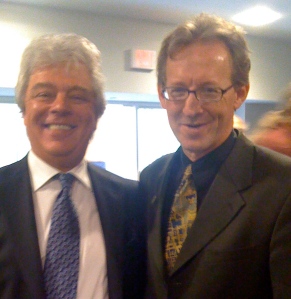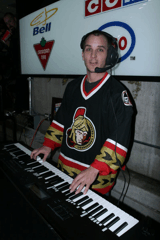 Some of the most fun I have is doing a number of Concert Preview conversations for the subscribers to the Washington Performing Arts Society and other performing-arts organizations in the D.C. area. Here’s what I’ve got on tap so far for the Winter/Spring of 2008:
Some of the most fun I have is doing a number of Concert Preview conversations for the subscribers to the Washington Performing Arts Society and other performing-arts organizations in the D.C. area. Here’s what I’ve got on tap so far for the Winter/Spring of 2008:
Sunday, February 3, 3:00 pm Kennedy Center Concert Hall
The Royal Concertgebouw Orchestra Amsterdam
Mariss Jansons, chief conductor
Truly one of the world’s great orchestras, with a powerhouse program to boot: Richard Strauss’ Don Juan and Gustav Mahler’s Symphony No. 5.
R. Strauss: Don Juan
Mahler: Symphony No. 5
Friday, February 8, 8:00 pm The Music Center at Strathmore
Orli Shaham, piano & Gil Shaham, violin
A concert I’m especially looking forward to…the siblings Shaham are engaging, energetic, and deeply musical. Two of the finest folks in classical music, IMHO.
Mozart: Sonata in D Major, K. 306
Fauré: Two Movements from Pelléas et Melisande
Szymanoski: Mythes, Op. 30
Bartók: Rhapsody No. 2
Prokofiev: Sonata No. 2 in D Major, Op. 94a
Monday, February 25, 8:00 pm Kennedy Center Concert Hall
Sir James Galway, flute
Lady Jeanne Galway, flute
Pianist & Program to be announced
Sir James Galway is certifiably in the Living Legend category…
Monday, March 3, 8:00 pm Kennedy Center Concert Hall
Joshua Bell, violin
Jeremy Denk, piano
Program TBA. Bell, like Galway, doesn’t need much introduction at this point. Jeremy Denk was one of our former Young Artists in Residence at NPR and his Think Denk blog is one of the most entertaining (and downright fascinating!) blogs in the business…
Tuesday, March 11, 8:00 pm Kennedy Center Concert Hall
Lang Lang, piano
The global phenomenon known as Lang Lang hits the KC stage….
Tuesday, April 1, 8:00 pm The Music Center at Strathmore
Swedish Chamber Orchestra
Piotr Anderszewski, piano
Another concert date that’s circled on the RoeDeo household calendar. Terrific 38-member ensemble with a “Gilmore Artist” – the equivalent of a “genius grant” for extraordinary pianists courtesy of the Irving S. Gilmore Festival & Foundation in Kalamazoo, MI.
Beethoven: Coriolan Overture,
Beethoven: Piano Concerto No. 1
Schumann: Symphony No. 2
Sunday, April 6, 7:00 pm Kennedy Center Concert Hall
Garrick Ohlsson, piano
Pianist Garrick Ohlsson is a “scintillating and superb technician who possesses arm-blurring speed and power” (The New York Times).
Prokofiev : Sonata No. 2 in D minor, Op.14
Chopin: Sonata No. 3 in B minor, Op. 58
Rachmaninoff: Variations on a Theme of Corelli, Op. 42
Scriabin: Etude in F-sharp minor, Op. 8 No. 2
Etude in B minor, Op. 8 No. 3
Poeme in F-sharp Major, Op. 32 No. 1
Sonata No. 5, Op. 53
Wednesday, April 16, 8:00 pm The Music Center at Strathmore
Emerson String Quartet
Wu Han, piano
D.C. favorites for three decades now, the Emerson String Quartet has won eight Grammy Awards including two for Best Classical Album, a rare feat for a chamber music group. Wu Han (wife of cellist David Finckel) joins the quartet to play the Schumann Piano Quintet.
Schubert: String Quartet in A minor, D. 804 “Rosamunde”
Janacek: String Quartet No. 2 “Intimate Letters”
Schumann: Piano Quintet in E-flat Major, Op. 44
Monday, April 28, 8:00 pm Kennedy Center Concert Hall
Orchestre National de France
Kurt Masur, music director
David Fray, piano
After a 17-year hiatus, the Orchestre National de France returns to D.C. under the leadership of Maestro Kurt Masur, former Music Director of the New York Philharmonic. Pianist David Fray joins the orchestra as soloist in Beethoven’s Second Piano Concerto.
Beethoven: Piano Concerto No. 2
Bruckner: Symphony No. 7
Sunday, May 4, 4:00 pm The Music Center at Strathmore
Itzhak Perlman, violin
Rohan DeSilva, piano
Perlman and DeSilva are back to play at the concert hall they helped to inaugurate.
Fall 2007 concert previews are listed here.











You must be logged in to post a comment.